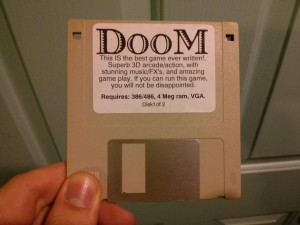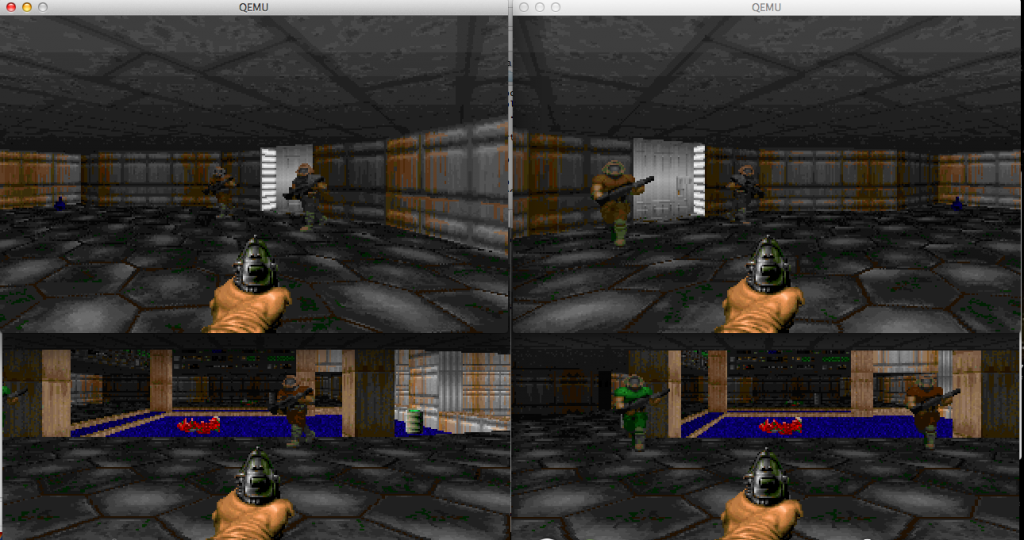So, since I’ve been starting up my virtual network thing, I got distracted with this thread on reddit
, talking about the good old days of Doom. Â Now Doom was revolutionary for the music, the sound effects, the 2.5D environment, the fast pace, the violence, the unlimited lives, dynamic lighting and of course LAN play. Â Now what was cool is that it could easily run over IPX/SPX networks. Â Although you did have to be on the same network it was very easy to setup, and get going. But as anyone can tell you, the moment you setup a four player deathmatch on a company LAN people would go nuts, as you would without a doubt bring the entire network to a halt. Â Back when I used to play this we would just disconnect the 10base2 cable from the lab 486DX2/50 PC’s and just make our own four computer segment. Â We did notice that if we had 3 four player games on the same network (afterhours!) that it was unplayable. Â I never did have access to a sniffer back then, and when I got a corporate job, being caught with something like Doom was grounds for termination so I never did get to see what the big deal was.
So I figured I’d cook up a super quick lab to check it out. Â This is my Dynagen configuration. Â Sadly I do need a cisco router to preform the network capture, although I don’t need to configure it to see what is going on.
autostart = True
[localhost]
[[7200]]
image = ../C7200-JS.BIN
npe = npe-400
ram = 160
idlepc = 0x60529c84
disk0 = 0
mmap = False
ghostios = True
[[ROUTER corertr1]]
model = 7200
slot1 = PA-8E
F0/0 = coresw1 5
[[ethsw coresw1]]
1 = access 1 NIO_udp:41300:127.0.0.1:51300
2 = access 1 NIO_udp:41301:127.0.0.1:51301
3 = access 1 NIO_udp:41302:127.0.0.1:51302
4 = access 1 NIO_udp:41303:127.0.0.1:51303
5 = access 1
As you can see this is very simple, a switch with four ports setup for four virtual computers, and a fifth port for the router. Â Next I run four instances of Qemu with a copy of Doom v1.1 shareware, and a IPX/SPX client. Â I fire them up like this:
./qemu/qemu-system-i386 -cpu pentium -L ./qemu/pc-bios/ -m 16 -hda doom11-00.img -soundhw sb16,adlib -net nic,model=pcnet,macaddr=00:11:22:33:44:00 -net socket,udp=localhost:41300,localaddr=0.0.0.0:51300 &
#
./qemu/qemu-system-i386 -cpu pentium -L ./qemu/pc-bios/ -m 16 -hda doom11-01.img -soundhw sb16,adlib -net nic,model=pcnet,macaddr=00:11:22:33:44:01 -net socket,udp=localhost:41301,localaddr=0.0.0.0:51301 &
#
./qemu/qemu-system-i386 -cpu pentium -L ./qemu/pc-bios/ -m 16 -hda doom11-02.img -soundhw sb16,adlib -net nic,model=pcnet,macaddr=00:11:22:33:44:02 -net socket,udp=localhost:41302,localaddr=0.0.0.0:51302 &
#
./qemu/qemu-system-i386 -cpu pentium -L ./qemu/pc-bios/ -m 16 -hda doom11-03.img -soundhw sb16,adlib -net nic,model=pcnet,macaddr=00:11:22:33:44:03 -net socket,udp=localhost:41303,localaddr=0.0.0.0:51303 &
Again all very simple.
From there I configure each of the four VM’s for a four player game, start the game, then connect.
I only had the game running for a few seconds when I went to my Dynagen console, and setup a capture session:
=> capture corertr1 fa0/0 doom.cap
=>
As you can see very simple. Â I walk the guys around a little bit, shoot someone, then just quit all the clients, and turn off the VM’s. Â Then I end the capture
=> no capture corertr1 fa0/0
=>
And now I’m left with a 50MB file!
$ ls -alh *cap
-rw-r–r– 1 jsteve staff 50M 25 Oct 14:27 doom.cap
I’m shocked! Â I wasn’t even running Doom that long! Â A quick peek reveals why Doom was never popular on corporate networks.
14:25:57.464031 IPX 00000000.00:11:22:33:44:00.869c > 00000000.ff:ff:ff:ff:ff:ff.869c: ipx-#869c 444
…
14:27:28.996489 IPX 00000000.00:11:22:33:44:01.869c > 00000000.ff:ff:ff:ff:ff:ff.869c: ipx-#869c 444
14:27:28.997618 IPX 00000000.00:11:22:33:44:03.869c > 00000000.ff:ff:ff:ff:ff:ff.869c: ipx-#869c 444
14:27:29.019568 IPX 00000000.00:11:22:33:44:01.869c > 00000000.ff:ff:ff:ff:ff:ff.869c: ipx-#869c 444
14:27:29.026000 IPX 00000000.00:11:22:33:44:03.869c > 00000000.ff:ff:ff:ff:ff:ff.869c: ipx-#869c 444
14:27:29.026205 IPX 00000000.00:11:22:33:44:01.869c > 00000000.ff:ff:ff:ff:ff:ff.869c: ipx-#869c 444
14:27:29.054425 IPX 00000000.00:11:22:33:44:01.869c > 00000000.ff:ff:ff:ff:ff:ff.869c: ipx-#869c 444
If you see the destination it is ff:ff:ff:ff:ff:ff, a broadcast packet.  And I have 50MB of this in the span of a minute and a half!  Even worse, opening the packet stream most of it is empty packets!
14:26:22.806014 IPX 00000000.00:11:22:33:44:00.869c > 00000000.ff:ff:ff:ff:ff:ff.869c: ipx-#869c 444
0x0000: e0e0 03ff ff01 da00 0000 0000 00ff ffff …………….
0x0010: ffff ff86 9c00 0000 0000 1122 3344 0086 ………..”3D..
0x0020: 9c00 0000 0000 0000 0001 0000 0001 0000 …………….
0x0030: 0002 0000 0000 0000 0000 0065 0000 0000 ………..e….
0x0040: 0000 0000 0000 0000 0000 0000 0000 0000 …………….
0x0050: 0000 0000 0000 0000 0000 0000 0000 0000 …………….
0x0060: 0000 0000 0000 0000 0000 0000 0000 0000 …………….
0x0070: 0000 0000 0000 0000 0000 0000 0000 0000 …………….
0x0080: 0000 0000 0000 0000 0000 0000 0000 0000 …………….
0x0090: 0000 0000 0000 0000 0000 0000 0000 0000 …………….
0x00a0: 0000 0000 0000 0000 0000 0000 0000 0000 …………….
0x00b0: 0000 0000 0000 0000 0000 0000 0000 0000 …………….
0x00c0: 0000 0000 0000 0000 0000 0000 0000 0000 …………….
0x00d0: 0000 0000 0000 0000 0000 0000 0000 0000 …………….
0x00e0: 0000 0000 0000 0000 0000 0000 0000 0000 …………….
0x00f0: 0000 0000 0000 0000 0000 0000 0000 0000 …………….
0x0100: 0000 0000 0000 0000 0000 0000 0000 0000 …………….
0x0110: 0000 0000 0000 0000 0000 0000 0000 0000 …………….
0x0120: 0000 0000 0000 0000 0000 0000 0000 0000 …………….
0x0130: 0000 0000 0000 0000 0000 0000 0000 0000 …………….
0x0140: 0000 0000 0000 0000 0000 0000 0000 0000 …………….
0x0150: 0000 0000 0000 0000 0000 0000 0000 0000 …………….
0x0160: 0000 0000 0000 0000 0000 0000 0000 0000 …………….
0x0170: 0000 0000 0000 0000 0000 0000 0000 0000 …………….
0x0180: 0000 0000 0000 0000 0000 0000 0000 0000 …………….
0x0190: 0000 0000 0000 0000 0000 0000 0000 0000 …………….
0x01a0: 0000 0000 0000 0000 0000 0000 0000 0000 …………….
0x01b0: 0000 0000 0000 0000 0000 0000 0000 0000 …………….
0x01c0: 0000 0000 0000 0000 0000 0000 0000 0000 …………….
0x01d0: 0000 0000 0000 0000 0069 0000 00 ………i…
Needless to say this could have been optimized a little better.. but at the same time back in 1993 this was the coolest thing ever. Â Even if it did have a reputation of destroying networks.
I can remember how loudly network people would complain about Doom, but it is kind of interesting to see it first hand how chatty it is. But at the same time, how exhilarating it was, for the first time we were playing against each other, not bots.
And speaking of this era, for those who may not have ever read about the rise & fall of iD, you may want to check out the book ‘Masters of Doom‘. Although the end is pretty much Old Man Murray. There is no mention of the soundcard disaster that was DMX, or anything about how deathmatch could crush a LAN. But I guess everything can’t be 100% for the time.



Ha. DMX was definitely one of the worse homebrew audio systems. Caused no end of trouble under Win9x and OS/2, just because the author was a bit clueless when it came to writing DPMI compatible code.
I was always amazed that v1.1 worked fine under OS/2, but all the ‘bugfixes’ and ‘improvements’ hopelessly broke it.
Neo, have you looked at this guy’s reviews about doom and quake http://fabiensanglard.net/
No, I haven’t but I’ll have to take a look. Thanks for the link!
http://kotaku.com/memories-of-doom-by-john-romero-john-carmack-1480437464
Looks like they know the problem exists 🙂